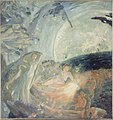Paul-Albert Besnard (2 June 1849 – 4 December 1934) was a French painter and printmaker.

photograph by Agence de presse Meurisse. Paris, Bibliothèque nationale de France.

Biography
Besnard was born in Paris and studied at the École des Beaux-Arts, studied with Jean Bremond and was influenced by Alexandre Cabanel. He won the Prix de Rome in 1874 with the painting Death of Timophanes.
On 19 November 1879 he married the sculptor Charlotte Dubray (1854–1931). They had four children, of whom three were artists.
Until about 1880 he followed the academic tradition, but then broke away completely, and devoted himself to the study of colour and light as conceived by the Impressionists. The realism of this group never appealed to his bold imagination, but he applied their technical method to ideological and decorative works on a large scale, such as his frescoes at the Sorbonne, the Ecole de Pharmacie, the ceiling of the Comédie-Française (main theatre in Paris), the Salle des Sciences at the Hôtel de Ville, the mairie of the 1st arrondissement, and the chapel of Berck hospital, for which he painted twelve Stations of the Cross in an entirely modern spirit.
A great virtuoso, he achieved brilliant successes alike in watercolour, pastel, oil and etching, both in portraiture, in landscape and in decoration. His close analysis of light can be studied in his picture La femme qui se chauffe at the Luxembourg in Paris, one of a large group of nude studies of which a later example is Une Nymphe au bord de la mer; and in the work produced during and after a visit to India in 1911. A large panel, Peace by Arbitration, was completed seven days before the outbreak of war in 1914.
Partly under the influence of Thomas Gainsborough and Joshua Reynolds, whom he studied during a three-years stay in England, he applied his methods to a brilliant series of portraits, especially of women. Notable among these are the Portrait de Théâtre (Madame Réjane), and Mme. Roger Jourdain. The former is a good example of his daring unconventionality. A later work is The King and Queen of Belgium (1919). His landscape work is represented by L'ile heureuse, and Un Ruisseau dans la Montagne (1920). A symbolist in his decorative work, Besnard's frank delight in the external world and his “chic” luminous technique bring him close to the 18th-century French painters.
A foundation member of the Société Nationale des Beaux-Arts in 1890, in 1913 he became a member of the Institute. He succeeded Carolus Duran as director of the Académie française in Rome. In 1912, he became a member of the French Académie des Beaux-Arts and became director of the École des Beaux Arts in 1922. In 1923 he co-founded the Salon des Tuileries.
He was represented in the official exhibition of French art held in the United States in 1919-20 by a symbolic 1917 portrait of Cardinal Mercier. An important exhibition of his works was shown in different cities of the United States in 1924.
Honours
- 1907 : Member of the Royal Academy of Science, Letters and Fine Arts of Belgium.
- commander of the Legion of Honour
- Member of the Société Nationale des Beaux-Arts
- 1924 : member of the Académie française (Seat #13).
- 1932: Honorary Corresponding member of the National Academy of Design.
Gallery
-
 Portrait of Madame Roger Jourdain (Henriette Jourdain), oil on canvas, 1886
Portrait of Madame Roger Jourdain (Henriette Jourdain), oil on canvas, 1886
-
 Morphine Addicts (Morphinomanes), etching, 1887
Morphine Addicts (Morphinomanes), etching, 1887
-
 Portrait of the Kharitonenko Sisters, oil on canvas, 1903, at the Pushkin Museum
Portrait of the Kharitonenko Sisters, oil on canvas, 1903, at the Pushkin Museum
-
 Femme pensive dans un sofa, pastel, 1890
Femme pensive dans un sofa, pastel, 1890
-
 The Truth leading the Sciences in its wake spreads its light
The Truth leading the Sciences in its wake spreads its light
-
 The Mystique (1908), depicting the Coronation of the Virgin
The Mystique (1908), depicting the Coronation of the Virgin
-
 A Martyr
A Martyr
Notes
- The New International Year Book, Published 1966. Dodd, Mead and Co.P 86
- Garric, Alain, "Charlotte DUBRAY", geneanet (in French), retrieved 2017-11-17
- New International Encyclopedia
- Index biographique des membres et associés de l'Académie royale de Belgique (1769-2005) p. 29
References
 This article incorporates text from a publication now in the public domain: Chisholm, Hugh, ed. (1911). "Besnard, Paul Albert". Encyclopædia Britannica (11th ed.). Cambridge University Press.
This article incorporates text from a publication now in the public domain: Chisholm, Hugh, ed. (1911). "Besnard, Paul Albert". Encyclopædia Britannica (11th ed.). Cambridge University Press. This article incorporates text from a publication now in the public domain: Colby, F.; Williams, T., eds. (1928). "Besnard, (Paul) Albert". New International Encyclopedia. Vol. III (2nd ed.). New York: Dodd, Mead. pp. 201–202.
This article incorporates text from a publication now in the public domain: Colby, F.; Williams, T., eds. (1928). "Besnard, (Paul) Albert". New International Encyclopedia. Vol. III (2nd ed.). New York: Dodd, Mead. pp. 201–202.- Constable, William George (1922). "Besnard, Paul Albert" . In Chisholm, Hugh (ed.). Encyclopædia Britannica (12th ed.). London & New York: The Encyclopædia Britannica Company.
External links
- Short biography in French
- Links to some of his paintings on line
- Paul-Albert Besnard in American public collections, on the French Sculpture Census website

| Académie française seat 13 | |
|---|---|
|
- 1849 births
- 1934 deaths
- Burials at Montparnasse Cemetery
- Painters from Paris
- 19th-century French painters
- 19th-century French male artists
- French male painters
- 20th-century French painters
- 20th-century French male artists
- Grand Cross of the Legion of Honour
- Prix de Rome for painting
- French Impressionist painters
- Members of the Royal Academy of Belgium
- Members of the Académie Française
- Honorary members of the Royal Academy